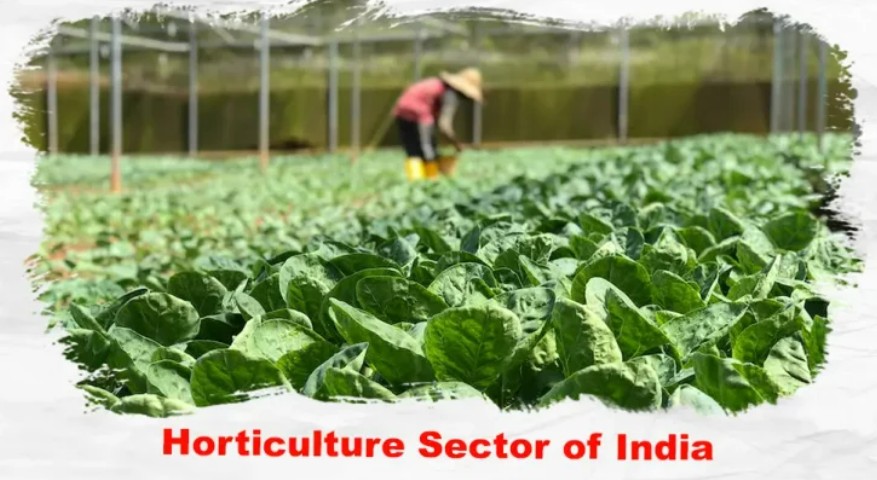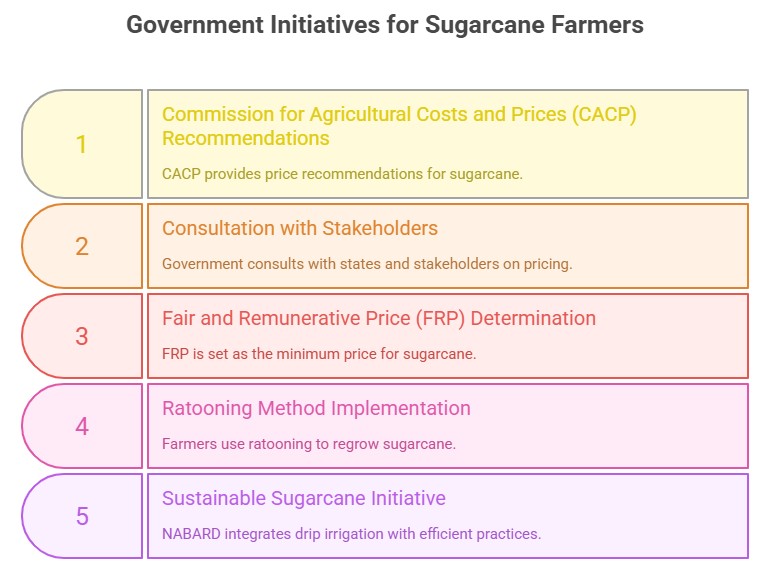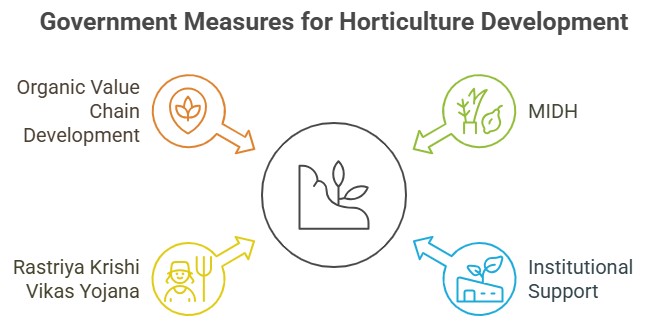Six sugarcane-producing northern Indian states saw a 42 per cent increase in their output value between 2011 and 2020 while that of five states from the south declined 32.4 per cent during the same period, according to the latest National Statistical Office (NSO) report.
Reasons of Northward Shift in Sugarcane Production
- Climate: With the changing climate patterns, the traditional sugarcane-growing regions in the south are becoming drier and hotter, making it difficult to grow sugarcane.
- Soil: The northern regions have fertile alluvial soils that are suitable for sugarcane cultivation.
- Water availability: Sugarcane require huge quantities of water for growth, and the northern regions have better irrigation facilities compared to the southern regions.
- Government policies: The government has been promoting sugarcane cultivation in the northern regions by providing subsidies and other incentives to farmers.
- Market demand: The demand for sugarcane is increasing due to the growth of the sugar industry in the northern regions.
Impact of Northward Shift
- Change in cropping pattern: Rice based to wheat based
- Soil pollution: Degradation of
- Ground water depletion; EX., PUNJAB CASE
- Non judicious fertiliser use; EX., HARYANA AND MADHYA PRADESH.
|
Government Initiatives for Sugarcane Farmers
- Fair and Remunerative Price (FRP): It is the minimum price that the sugar mills have to pay to farmers. It is determined based on recommendations of the Commission for Agricultural Costs and Prices (CACP) and after consultation with State Governments and other stakeholders.
- Ratooning: In this method, during the first harvest, the sugarcane is cut, leaving a little bit of the stalk in the soil with the roots. The stem soon puts out new shoots or ratoons.
- Sustainable sugarcane initiative: It is an innovative credit-plus approach of NABARD, which helps integrate the twin drip irrigation system with resource-efficient sugarcane agricultural practices.
Climate Smart Agriculture: An Overview
- An integrated approach to managing landscapes to mitigate climate change impacts, adapt to climate variability, and promote sustainable development.
- Encompasses range of techniques and approaches that optimize productivity, resilience, and sustainability of agricultural systems in the face of climate change.
- It pursues the triple objectives of sustainably increasing productivity and incomes, adapting to climate change and reducing greenhouse gas emissions where possible; however, it does not necessarily result into “triple wins” at every location.
3 Pillars of Climate Smart Agriculture
|
Sustainable agriculture:
|
Climate adaptation
|
Climate mitigation
|
- This involves the use of sustainable farming practices such as conservation tillage, crop rotation, intercropping, agroforestry, and integrated pest management.
- These practices help to conserve soil moisture, reduce soil erosion, and improve soil fertility, which enhances agricultural productivity.
|
- This involves the use of strategies to increase the resilience of agricultural systems to climate change.
- These include the use of drought-resistant crops, improved water management techniques, and the development of early warning systems for extreme weather events.
|
- This involves the use of strategies to reduce greenhouse gas emissions from agriculture.
- These include the use of renewable energy sources, such as solar and wind power, and the adoption of practices that reduce emissions from livestock and fertilizer use.
|
Overall, CSA aims to promote sustainable and resilient agricultural systems that contribute to food security and mitigate climate change.
Significance of Climate Smart Agriculture
|
Agricultural
|
Ecological
|
Economical
|
- Increases resilience for climate tragedy
- Increased productivity
- Reduces soil pollution
- Increases resource use efficiency & support diversification
|
- Reduces chances of soil pollution
- Reduces eutrophication
- Reduces land degradation
- Increases soil microbial capacity.
- Reduces climate impact on agriculture
|
- Increase productivity
- Stabilize farm income
- Increases chances of employment.
- Allied technologies increases economic values.
|
Government Initiatives for Promoting Climate Smart Agriculture
The Indian government has launched several initiatives to promote climate smart agriculture in the country.
- National Innovation on Climate Resilient Agriculture (NICRA): To enhance the resilience of agriculture to climatic variability through development and application of improved production and risk management technologies.
- Pradhan Mantri Fasal Bima Yojana (PMFBY): For reducing vulnerability to climate-related risks.
- Soil Health Card Scheme: to promote sustainable agriculture practices by providing farmers with information on soil health and nutrient management.
- National Mission for Sustainable Agriculture (NMSA) is a flagship program that aims to promote climate-resilient farming practices such as conservation agriculture, agroforestry, and integrated farming systems.
National Innovations in Climate Resilient Agriculture (NICRA)
- It is a program launched by the Indian government in 2011 to enhance the resilience of Indian agriculture to climate change.
- Aim- The program aims to address the challenges of climate change by promoting sustainable and climate-smart agricultural practices, developing technologies and tools for climate risk management.
- It is implemented by ICAR in collaboration with state agricultural universities, research institutions, and other stakeholders.
- Objectives:
- To enhance the resilience of Indian agriculture which covers crops, livestock and fisheries
- To demonstrate site-specific technology packages on farmers’ fields
- To enhance the capacity building of scientists and other stakeholders in climate-resilient agricultural research and its application
|
|
Key facts
An increase in temperature by 1.5° C and decrease in the precipitation of 2 mm, reduces rice yield by 3 to 15 percent.
- While global emissions from deforestation dropped, emissions from forest degradation (logging, fires etc) increased from 0.4 to 1.0 Gt CO2 per year between 1990 and 2015.
|
Horticulture Sector
It is the science of the development, sustainable production, marketing and use of high-value, intensively cultivated food, and ornamental plants.

Horticulture sector in India: Present Status
- It contributes about 35% to Agricultural GDP, from just 16% of the total cropped area, and supports 20% of the agriculture labour force.
- Production has more than doubled from 146 million tonnes in 2001-02 to 340 mt in 2021-22.
- Significant Expansion in Acreage (18%) Vis A Vis Foodgrains (5%) – (2010 – 2015).
- Global Position - India is the 2nd largest producer of fruits and vegetables in the world (after China).
India has emerged as world leader in the production of a variety of fruits like mango, banana, guava, papaya, etc.
Government Measures for Horticulture Development
- Mission for Integrated Development of Horticulture (MIDH): For holistic growth of the horticulture sector covering fruits, vegetables, root & tuber crops, mushrooms, spices, flowers, aromatic plants, coconut, cashew, cocoa and bamboo.
- Institutional Support: National Horticulture Board (NHB), Coconut Development Board (CDB), Central Institute for Horticulture (CIH), etc.
- Rastriya Krishi Vikas Yojana supports horticulture activities.
- Mission Organic Value Chain Development in North Eastern Region: Ginger, Turmeric, King Chilly, Pineapple & Lemon are being exported from India to Swaziland, Australia, USA, UK & Dubai.
Challenges in the Horticulture Sector
- Low Productivity - Due to small, segregated farms with low per-hectare yields, lack of access to quality seed materials.
- Multiplicity of Intermediaries leads to high consumer prices on one hand, and low-price realization by farmers on the other.
- Distress Sale faced by excess production, and difficulty in access to markets produce to contain losses.
- High Post-harvest Losses - Due to perishable nature of the produce, lack of market support and paucity of the post production infrastructure for distribution, storage and value-addition.
- Lack of institutional finance for investments in micro-irrigation systems, construction of green houses and grading and packaging.
- Lack of private investment due to problem of land leasing & contract farming and cooperative farming.
- Impact on Exports – Low exportable surplus, poor quality produce, gap in market intelligence, high tariff/non-tariff barrier etc. affect market access for export of horticultural commodities.
- Climate change – Drought, flood, high temperature, salinity and new pathogens.
- Marketing issues leading to fluctuations in prices (Cobweb phenomenon)
Way Ahead
- Ensuring availability of quality seeds/planting material for better quality and yield of produce.
- Strengthening of horticulture support industry like food processing, logistics, packaging, etc
- Diversification of horticultural crops along with other activities viz. bee keeping, backyard poultry etc.
- Popularisation of cooperative farming in horticultural crops for round the year supply.
- Infusion of recent Scientific Advances on Crop Production Technologies – to improve operational efficiency and reduce costs ???? Promote Technologies at grassroot level.
- Promote Sustainable farming practices such as organic farming, drip irrigation etc.
- Stable policy regime to prevent violent price fluctuations.
- Promotion of horti-tourism in states like J&K, HP, Uttarakhand, and north-eastern state
Conclusion
The development of horticulture sector in India holds importance in ensuring food and nutrition security and doubling farmers’ incomes.













